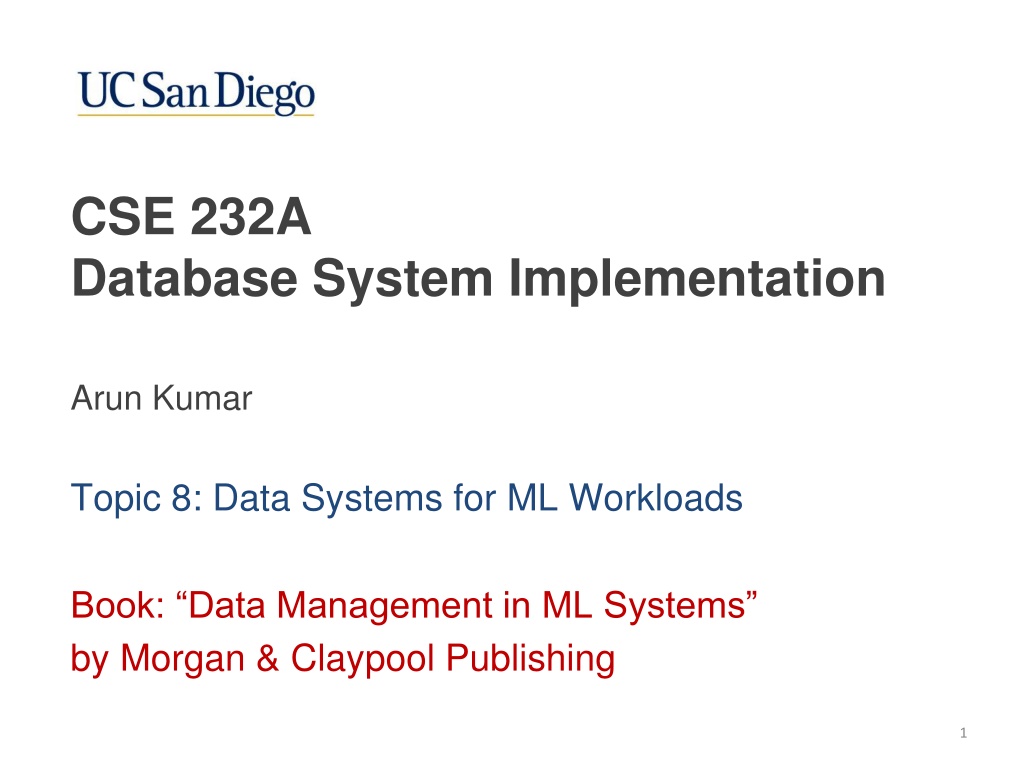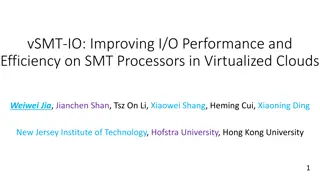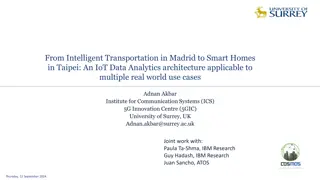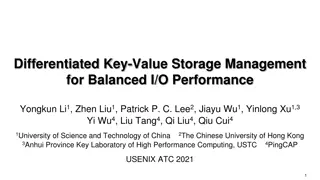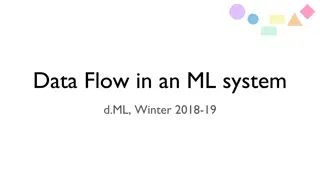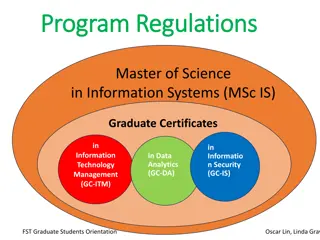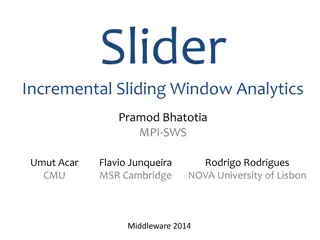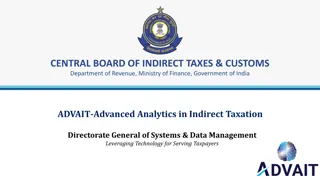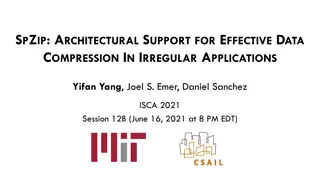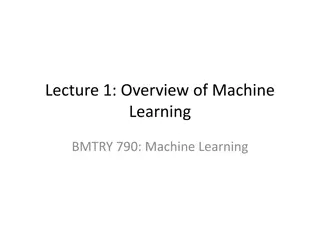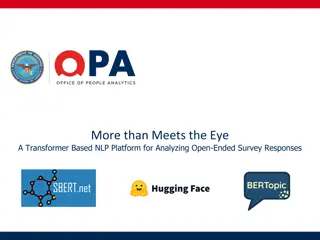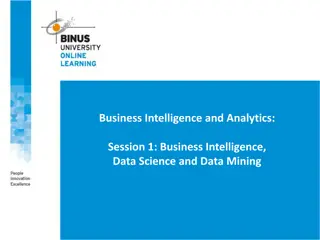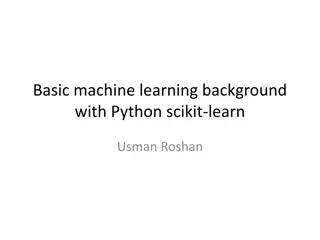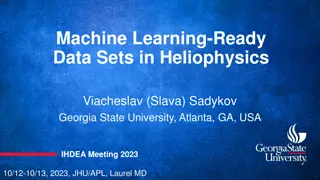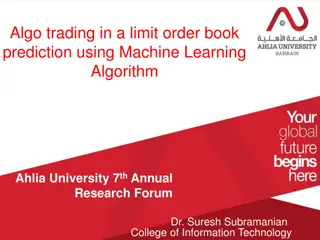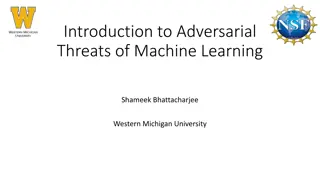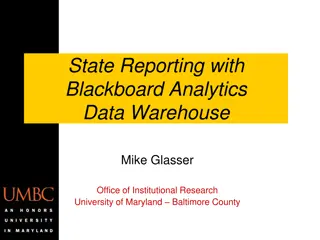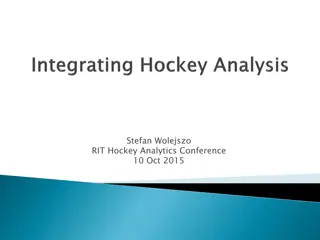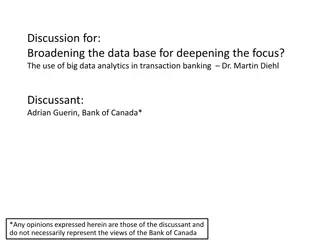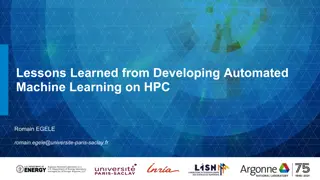Data Systems for Machine Learning Workloads and Advanced Analytics
This content explores the intersection of database systems with machine learning workloads, covering topics such as big data systems, ML lifecycle tasks, popular forms of ML, and data management concerns in ML systems. It delves into the importance of ML systems for mathematically advanced data analysis operations beyond traditional SQL aggregates, emphasizing the need for high-level APIs and addressing key practical concerns in ML system development. The visuals provided offer insights into various aspects of ML, including feature engineering, model training, and inference, making it a comprehensive resource for understanding the evolving landscape of data management in ML environments.
Download Presentation

Please find below an Image/Link to download the presentation.
The content on the website is provided AS IS for your information and personal use only. It may not be sold, licensed, or shared on other websites without obtaining consent from the author. Download presentation by click this link. If you encounter any issues during the download, it is possible that the publisher has removed the file from their server.
E N D
Presentation Transcript
CSE 232A Database System Implementation Arun Kumar Topic 8: Data Systems for ML Workloads Book: Data Management in ML Systems by Morgan & Claypool Publishing 1
Big Data Systems Parallel RDBMSs and Cloud-Native RDBMSs Beyond RDBMSs: A Brief History Big Data Systems The MapReduce/Hadoop Craze Spark and Other Dataflow Systems Key-Value NoSQL Systems Graph Processing Systems Advanced Analytics/ML Systems 2
Lifecycle/Tasks of ML-based Analytics Feature Engineering Training Model Selection Data acquisition Data preparation Inference Monitoring 3
ML 101: Popular Forms of ML Generalized Linear Models (GLMs); from statistics Bayesian Networks; inspired by causal reasoning Decision Tree-based: CART, Random Forest, Gradient- Boosted Trees (GBT), etc.; inspired by symbolic logic Support Vector Machines (SVMs); inspired by psychology Artificial Neural Networks (ANNs): Multi-Layer Perceptrons (MLPs), Convolutional NNs (CNNs), Recurrent NNs (RNNs), Transformers, etc.; inspired by brain neuroscience 4
Advanced Analytics/ML Systems Q: What is a Machine Learning (ML) System? A data processing system (aka data system) for mathematically advanced data analysis ops (inferential or predictive), i.e., beyond just SQL aggregates Statistical analysis; ML, deep learning (DL); data mining (domain-specific applied ML + feature eng.) High-level APIs for expressing statistical/ML/DL computations over large datasets 5
Data Management Concerns in ML Key concerns in ML: Q: How do ML Systems relate to ML? Accuracy Runtime efficiency (sometimes) Additional key practical concerns in ML Systems: Scalability (and efficiency at scale) Usability Manageability Developability ML Systems : ML :: Computer Systems : TCS Long-standing concerns in the DB systems world! Q: What if the dataset is larger than single-node RAM? Q: How are the features and models configured? Q: How does it fit within production systems and workflows? Q: How to simplify the implementation of such systems? Can often trade off accuracy a bit to gain on the rest! 6
Conceptual System Stack Analogy Relational DB Systems ML Systems Learning Theory Optimization Theory First-Order Logic Complexity Theory Theory Matrix Algebra Gradient Descent Program Formalism Relational Algebra Declarative Query Language TensorFlow? R? Scikit-learn? Program Specification Program Modification Query Optimization ??? Parallel Relational Operator Dataflows Execution Primitives Depends on ML Algorithm CPU, GPU, FPGA, NVM, RDMA, etc. Hardware 7
Categorizing ML Systems Orthogonal Dimensions of Categorization: 1. Scalability: In-memory libraries vs Scalable ML system (works on larger-than-memory datasets) 2. Target Workloads: General ML library vs Decision tree-oriented vs Deep learning, etc. 3. Implementation Reuse: Layered on top of scalable data system vs Custom from-scratch framework 8
Major Existing ML Systems General ML libraries: In-memory: Disk-based files: Layered on RDBMS/Spark: Cloud-native: AutoML platforms: Decision tree-oriented: Deep learning-oriented: 9
ML as Numeric Optimization Recall that an ML model is a parametric function: Training: Process of fitting model parameters from data Training can be expressed in this form for many ML models; aka empirical risk minimization (ERM) aka loss function: is a training example l() is a differentiable function; can be compositions GLMs, linear SVMs, and ANNs fit the above template 10
Key Algo. For ML: Gradient Descent Goal of training is to find minimizer: Not possible to solve for optimal in closed form usually Gradient Descent (GD) is an iterative procedure to get to an optimal solution: Gradient Update rule at iteration t: Learning rate hyper-parameter Each iteration/pass aka epoch akin to a SQL aggregate! Typically, multiple of epochs needed for convergence 11
GD vs Stochastic GD (SGD) Disadvantages of GD: An update needs pass over whole dataset; inefficient for large datasets (> millions of examples) Gets us only to a local optimal; ANNs are non-convex Stochastic GD (SGD) resolves above issues: Popular for large-scale ML, especially ANNs/deep learning Updates based on samples aka mini-batches; batch sizes: 10s to 1000s; OOM more updates per epoch than GD! Sample mini-batch from dataset without replacement 12
Data Access Pattern of SGD Sample mini-batch from dataset without replacement Original dataset Randomized dataset Epoch 1 Epoch 2 Random shuffle Seq. scan Seq. scan Mini-batch 1 (Optional) New Random Shuffle Mini-batch 2 Mini-batch 3 ORDER BY RAND() 13
Data Access Pattern of SGD An SGD epoch is similar to SQL aggs but also different: More complex agg. state (running info): model param. Multiple mini-batch updates to model param. within a pass Sequential dependency across mini-batches in a pass! Need to keep track of model param. across epochs (Optional) New random shuffling before each epoch Not an algebraic aggregate; hard to parallelize! Not even commutative: different random shuffle orders give different results (very unlike relational ops)! Q: How to implement scalable SGD in an ML system? 14
Bismarck: Single-Node Scalable SGD An SGD epoch runs in RDBMS process space using its User-Defined Aggregate (UDA) abstraction with 4 functions: Initialize: Run once; set up info; alloc. memory for Transition: Run per-tuple; compute gradient as running info; track mini-batches and update model param. Merge: Run per-worker at end; combine model param. Finalize: Run once at end; return final model param. Commands for shuffling, running multiple epochs, checking convergence, and validation/test error measurements issued from an external controller written in Python https://adalabucsd.github.io/papers/2012_Bismarck_SIGMOD.pdf 15
Combining SGD Model Parameters RDBMS takes care of scaling UDA code to larger-than-RAM data and distributed execution across workers Tricky part: How to combine model params. from workers, given that an SGD epoch is not an algebraic agg.? Master typically performs Model Averaging Master A bizarre heuristic! Works OK for GLMs Terrible for ANNs! Worker 1 Worker 2 Worker n 16
ParameterServer for Distributed SGD Disadvantages of Model Averaging for distributed SGD: Poor convergence for non-convex/ANN models; leads to too many epochs and typically poor ML accuracy UDA merge step is choke point at scale (n in 100s); model param. size can be huge (even GBs); wastes resources ParameterServer is a more flexible from-scratch design of an ML system specifically for distributed SGD: Break the synchronization barrier for merging: allow asynchronous updates from workers to master Flexible communication frequency: at mini-batch level too 17 https://www.cs.cmu.edu/~muli/file/parameter_server_osdi14.pdf
ParameterServer for Distributed SGD Multi-sever master ; each server manages a part of PS 1 PS 2 PS 2 No sync. for workers or servers Push / Pull when ready/needed Workers send gradients to master for updates at each mini-batch (or lower frequency) Worker 1 Worker 2 Worker n Model params may get out-of-sync or stale; but SGD turns out to be remarkably robust multiple updates/epoch really helps Communication cost per epoch is higher (per mini-batch) 18
Deep Learning Systems Offer 3 crucial new capabilities for DL users: High-level APIs to easily construct complex neural architectures; aka differentiable programming Automatic differentiation( autodiff ) to compute Automatic backpropagation: chain rule to propagate gradients and update model params across ANN layers Neural computational graphs compiled down to low-level hardware-optimized physical matrix ops (CPU, GPU, etc.) In-built support for many variants of GD and SGD Wider tooling infra. for saving models, plotting loss, etc. 19
Machine Learning Systems Takeaway: Scalable, efficient, and usable systems for ML have become critical for unlocking the value of Big Data If you are interested in learning more about this topic, read my recent book Data management ML Systems : https://www.morganclaypool.com/doi/10.2200/S00895ED1V01Y201901DTM057 https://www.morganclaypoolpublishers.com/catalog_Orig/product_info.php?products_id=1366 Advertisement: I will offer CSE 291/234 titled Data Systems for Machine Learning in Fall 2020 20
